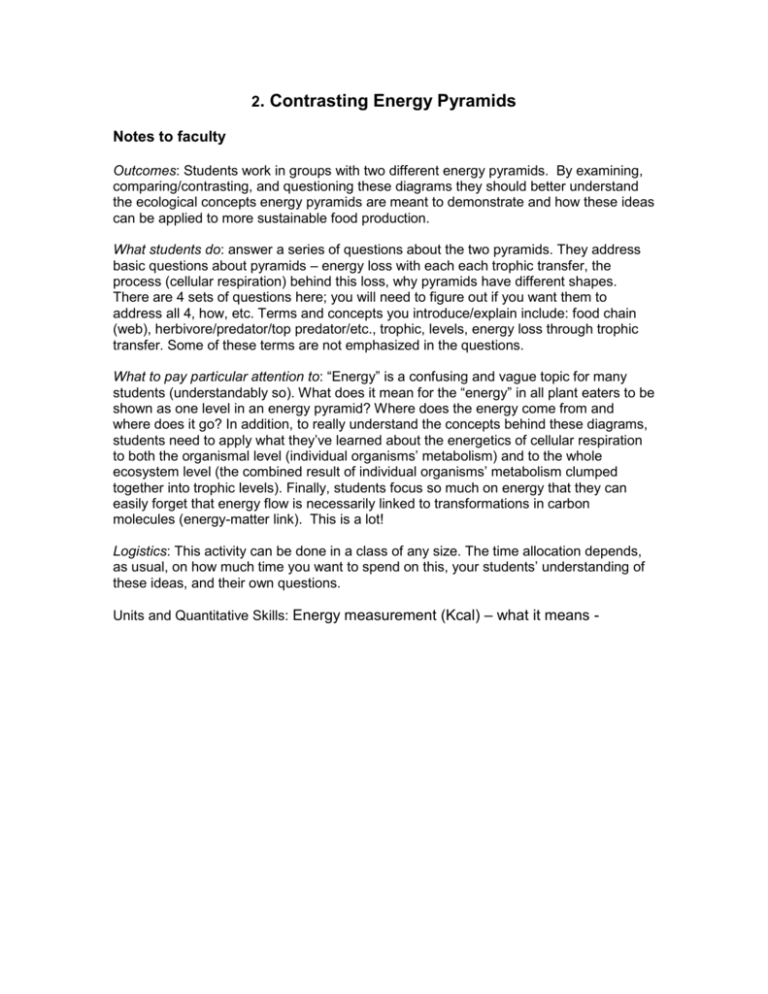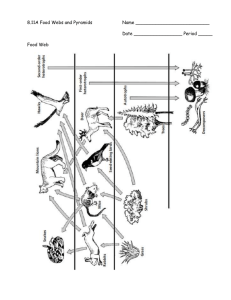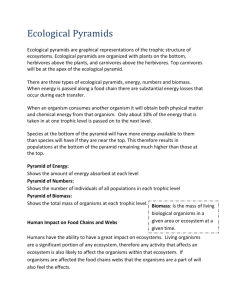2.EF_Energy_Pyramid_
advertisement

2. Contrasting Energy Pyramids Notes to faculty Outcomes: Students work in groups with two different energy pyramids. By examining, comparing/contrasting, and questioning these diagrams they should better understand the ecological concepts energy pyramids are meant to demonstrate and how these ideas can be applied to more sustainable food production. What students do: answer a series of questions about the two pyramids. They address basic questions about pyramids – energy loss with each each trophic transfer, the process (cellular respiration) behind this loss, why pyramids have different shapes. There are 4 sets of questions here; you will need to figure out if you want them to address all 4, how, etc. Terms and concepts you introduce/explain include: food chain (web), herbivore/predator/top predator/etc., trophic, levels, energy loss through trophic transfer. Some of these terms are not emphasized in the questions. What to pay particular attention to: “Energy” is a confusing and vague topic for many students (understandably so). What does it mean for the “energy” in all plant eaters to be shown as one level in an energy pyramid? Where does the energy come from and where does it go? In addition, to really understand the concepts behind these diagrams, students need to apply what they’ve learned about the energetics of cellular respiration to both the organismal level (individual organisms’ metabolism) and to the whole ecosystem level (the combined result of individual organisms’ metabolism clumped together into trophic levels). Finally, students focus so much on energy that they can easily forget that energy flow is necessarily linked to transformations in carbon molecules (energy-matter link). This is a lot! Logistics: This activity can be done in a class of any size. The time allocation depends, as usual, on how much time you want to spend on this, your students’ understanding of these ideas, and their own questions. Units and Quantitative Skills: Energy measurement (Kcal) – what it means - Hidden Curriculum addressed • Principles: Conservation of Energy (why energy is “lost” with each trophic transfer, where the “energy comes from and where it goes) • Processes: Generation (photosynthesis); Transformation (building of biomolecules within an organism, consumption of one organism by another); Oxidation (autotrophic respiration, heterotrophic respiration, decomposition) • Scale & Time: molecular/cellular/organismal processes collectively contribute to ecosystem processes; this a “snapshot” in time. • Forms & Representations: Ecosystems Matter & Energy Flow - energy pyramids signify specific ecological processes and concepts to ecosystems ecologists; they are tools that organize thinking and ideas about ecosystems ecology. Energy comes in different forms (sunlight, animal and plant biomass). Student Directions Below are two “energy pyramids”: one for a grassland ecosystem and other a marine (ocean) ecosystem. Please address the questions below as best you can. Write down any questions you have, such as parts of the diagrams you don’t understand (e.g. what they are suppose to show) and the ecology concepts the diagrams are suppose to help you understand. Your comments and questions will be key for the all-class discussion about this topic. PYRAMID I: Grassland ecosystem (Organisms include - Primary Producers (such as grasses), Herbivores (e.g. grasshoppers, bison), Primary Predators (they eat herbivores – e.g. spiders), Secondary Predators (eat primary predators – e.g. some birds), Tertiary Predators (eat secondary predators – e.g. hawks). PYRAMID 2. Marine Ecosystem (Organisms include – Primary Producers (phytoplankton – small floating algae), Herbivores (they eat the primary producers - zooplankton – small floating animals, Predators (eat zooplankton – e.g. some fish) Questions: One person in your group should read the paragraph immediately below. Make sure everybody in the group understands what is being said here before you move on. “Energy pyramids” are shown in all biology and ecology textbooks to demonstrate some core ideas in ecosystems ecology. These concepts are key to sustainable agriculture and energy production as well as basic biology and ecology. An energy pyramid describes the amount of energy in different parts of a particular ecosystem at one point in time – for instance, for a corn farm field on an average summer day. So the concentration of energy contained in the corn, insects eating the corn, predators eating these herbivorous insects, other predators eating them, and so on – is depicted in each level of the energy pyramid. 1. Describe each pyramid above and compare/contrast them. What are the horizontal boxes meant to represent? What are the arrows? Why so much emphasis on the arrows? There are no units shown here. What could be units be? (what is being measured here?). What are the main differences between Pyramids 1 and 2? Why are the horizontal boxes smaller from bottom to top? Where does the energy come from for the whole ecosystem? Write you answers below along with any comments or questions. 2. A vegetarian would point to the difference between the two pyramids as evidence for why being a vegetarian is a good thing for environmentally conscious people. Why? 3. The dotted arrows show energy as being “lost” to the ecosystem. Is it “lost”? Where does the energy go? Where – what key biological process – does it come from? Where does that process take place? What organisms in an ecosystem “do” this process? Why do they do it? 4. Imagine that you are given the task of actually making an energy pyramid for an acre of corn. How would you go about doing this? What would be the first step? Hint: imagine piles of organisms group by category – the plants in one pile, the herbivores in a pile next to the plants, and so on. Draw the piles in a cartoon below.









